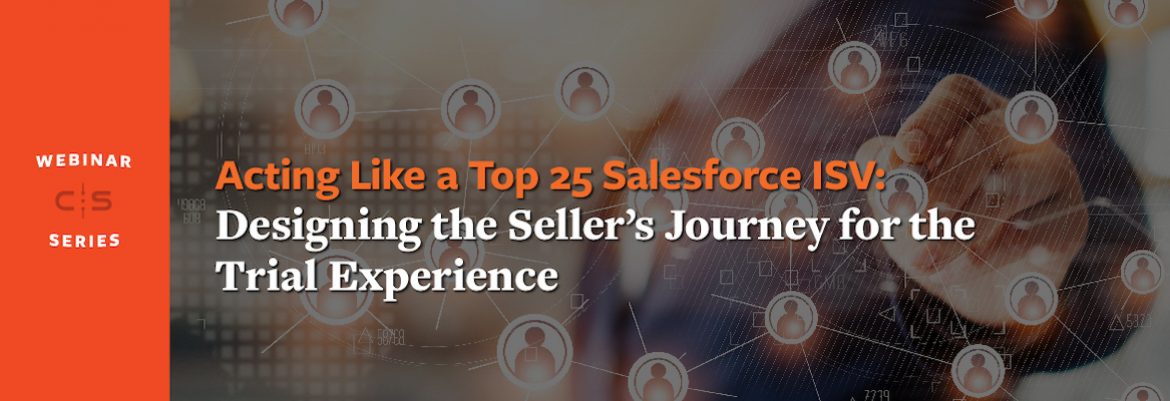
Our Acting Like a Top 25 Salesforce ISV webinar series offers insight into the tactics and strategies leading ISVs leverage to achieve business success with Salesforce. Following our last Top 25 ISV webinar on designing the buyer’s journey, the latest installation focuses on designing the seller’s journey within the trial experience.
A successful trial experience takes more than just putting the product in your customer’s hands — you need close coordination between your Marketing, Sales, and Support teams and a clear and repeatable lead to sale process. In this webinar, CodeScience CRO, Sean Hogan, is joined by Craig Rosenberg, Co-Founder and Chief Analyst at TOPO (now Gartner), to discuss how ISVs can create a rock-solid seller’s journey that will close more deals on the AppExchange.
Register now to watch the webinar and download a copy of the slides.
Who Are Your Sellers?
Sean starts out by clarifying that the seller’s journey is a team sport. “You may not realize it,” he explains. “It’s not just your sales team, it’s your sales engineers; it’s your demo environment; it’s your product marketing team building the buyer’s story; it’s your listing on the AppExchange; it’s your alliances team, and your executives. And do not forget about leveraging Salesforce!” As you tighten up everything that goes into your trial experience, Sean urges ISVs to promote that information and messaging to Salesforce so they can understand your process and help you succeed.
Designing the Seller’s Journey
Craig notes that, in studying high performing SaaS organizations, “we started to notice that two-thirds of them had a well-defined sales process. That’s a big deal!” This stat, Craig believes, demonstrates that designing a clear and specific seller’s journey is one of the most important things ISVs can do to increase sales.
How do we define the seller’s journey? Craig explains that it is a standardized set of activities that define how we take a buyer from qualification to close — essentially, a sales roadmap. “You lay out a series of steps and you ask your people to repeat those steps, then you measure it, and refine it over time,” Sean adds.
Craig emphasizes that each step in this sales process should include specific actions. For example, in the sales process design template he shares, the exit criteria includes “words like document, schedule. These are things that you do. On exit criteria, a lot of people put sort of pie-in-the-sky things like understand,” he explains. “If you just put understand, that leaves it gray. We have to be able to think about things that are very concrete. And then when they’re done, we go to the next step.”
Trends and Traps in the Trial Experience
Craig then reviews some surprising statistics on the trial experience and traps that can sabotage the seller’s journey. Most notably, a shocking 51% of trials fail because sales reps haven’t properly defined the success criteria, thus failing to manage buyer expectations. “Trials are not ‘set it and forget it’,” Craig notes. It’s not enough to just have a great product and put it in the buyer’s hands. “I know your product’s amazing. But the key to the trial is setting up the buyer for success.”
ISVs must provide a structure and a set of expectations for every trial, along with a regular cadence of communication, in order to keep the trial on track, Craig warns. “If you don’t set up these checkpoints where you can go communicate with the prospect, the trial may go off the rails, and you won’t know.”
What ISVs Can Do Now to Improve the Seller’s Journey
To wrap up the webinar, Craig and Sean walk us through a series of detailed trial management templates that ISVs can use to ensure their buyers are focused on the right things throughout the trial experience, including an overview of the trial objectives and timeline. They also provide practical, actionable checklists to help ISVs who are in the process of building or reimagining their seller’s journey and overall trial experience.
Craig closes with a key insight that ISVs should keep in mind when designing their seller’s journey: “Sellers are meeting-centric. When you think about the seller’s journey, when you think about the trial experience, the best thing you can do is to center the milestones around meetings.” This is an excellent way to design your sales process in a way that makes it easy for your sales team to adopt, in addition to tying the seller’s journey to tangible, actionable events.
To hear more from Sean and Craig and get a copy of the deck, along with a set of useful trial management templates, register and watch the full webinar here.
Companies build their Salesforce businesses better with CodeScience. It is our mission that no ISV navigates Salesforce alone. If you’re looking for guidance on your product, help supporting your customers, or just need to ask an expert, get in touch today!


